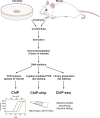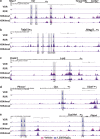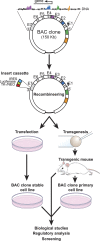Regulation of gene expression by 1,25-dihydroxyvitamin D3 in bone cells: exploiting new approaches and defining new mechanisms
- PMID: 24466413
- PMCID: PMC3899561
- DOI: 10.1038/bonekey.2013.216
Regulation of gene expression by 1,25-dihydroxyvitamin D3 in bone cells: exploiting new approaches and defining new mechanisms
Abstract
The biological actions of 1,25-dihydroxyvitamin D3 (1,25(OH)2D3) serve both to orchestrate calcium and phosphorus homeostasis in higher vertebrates and to regulate a diverse set of cellular functions unrelated to control of mineral metabolism. With regard to bone, mesenchymal lineage cells, including both early and late osteoblasts as well as osteocytes represent classic targets of the vitamin D hormone. Accordingly, much of the early information regarding our current understanding of the mechanism of action of 1,25(OH)2D3, of which gene regulation is central, derives from a broad array of studies in these cell types. Indeed, a gene that provided both the earliest and perhaps the most extensive information regarding this and additional mechanisms was that of osteoblast-specific osteocalcin. Subsequent work has provided much additional detail as to how 1,25(OH)2D3, through the vitamin D receptor (VDR), mediates the modulation of many bone cell genes. In recent years, however, a series of technical advances involving the coupling of chromatin immunoprecipitation (ChIP) to unbiased methodologies that involve next-generation DNA sequencing techniques (ChIP-seq) have opened new avenues in the study of gene regulation. In this review, we summarize early work and then focus on more recent studies that have used ChIP-seq analysis and other approaches to provide insight into not only the regulation of specific genes such as the VDR, TNFSF11 (RANKL), LRP5, CBS and CYP24a1, but overarching genome-wide principles of gene regulation as well. The results of these studies highlight the value of these new approaches and the increased insight that can be gained.
Conflict of interest statement
The authors declare no conflict of interest.
Figures



References
-
- Brumbaugh P, Haussler M. 1 Alpha,25-dihydroxycholecalciferol receptors in intestine. I. Association of 1 alpha,25-dihydroxycholecalciferol with intestinal mucosa chromatin. J Biol Chem 1974;249:1251–1257. - PubMed
-
- Brumbaugh PF, Haussler MR. 1a,25-Dihydroxycholecalciferol receptors in intestine. II. Temperature-dependent transfer of the hormone to chromatin via a specific cytosol receptor. J Biol Chem 1974;249:1258–1262. - PubMed
-
- Chandler J, Pike J, Haussler M. 1,25-Dihydroxyvitamin D3 receptors in rat kidney cytosol. Biochem Biophys Res Commun 1979;90:1057–1063. - PubMed
-
- Kream B, Jose M, Yamada S, DeLuca H. A specific high-affinity binding macromolecule for 1,25-dihydroxyvitamin D3 in fetal bone. Science 1977;197:1086–1088. - PubMed
Publication types
Grants and funding
LinkOut - more resources
Full Text Sources
Other Literature Sources
